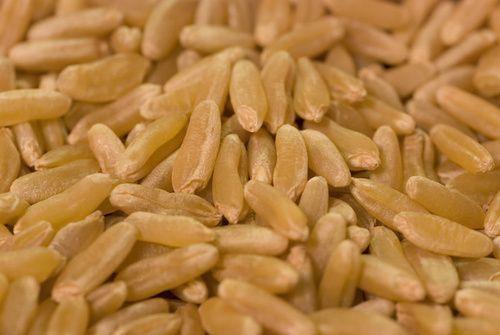The kamut (Khorasan wheat) is a cereal belonging to the Graminaceae family. Rich in nutrients and proteins, it is known for its property antioxidants.
For simplicity it is called this way, but in reality the term KAMUT® refers to the registered trademark to distinguish a specific variety of khorasan wheat with certain characteristics; it is therefore not the trade name of khorasan wheat nor is it a subcategory of it. It would therefore not be correct to speak simply of KAMUT®, since the exact wording should always be KAMUT® khorasan wheat.
Let's find out better.
> 2. Properties and benefits of kamut
> 3. Calories and nutritional values of kamut
> 4. Ally of
> 5. Curiosities about kamut

Description of the kamut
Its appearance is similar to that of regular wheat, but it has larger grains. The kamut it is a very ancient cereal and was cultivated in Egypt as early as 6000 years ago.
It was little known in the Western world until the XNUMXs. In the country it is still a little used cereal even if, in recent years, its diffusion has been increasing.
Its notoriety is also due to the fact that, according to some studies conducted mainly in the United States, 70% of those suffering from food intolerances with respect to the common wheat can safely consume Kamut wheat.
However, this rule does not apply to the celiac disease; the Kamut, in fact, contains gluten.
Properties and benefits of kamut
It is considered one of the most complete cereals from a nutritional point of view. It is mainly composed of carbohydrates, but it also contains a good amount of protein, about 40% more than wheat.
It boasts a content of Vitamin E much greater than that of wheat and the amount of amino acids is also higher.
Kamut also contains a good share of selenium, Which has antioxidant properties.
Calories and nutritional values of kamut
100 g of kamut contains 342 kcal.
Carbohydrates represent 66% of the weight, proteins 17%, water 11%, fats 2,5%. Cholesterol, on the other hand, is completely absent in kamut, therefore this cereal is suitable for hypercholesterolemics.
Kamut, ally of
Heart, arteries, immune system, eyes.
You can learn more about the correct diet against high cholesterol

Fun facts about kamut
- Kamut is grown only with methods of organic farming; this cereal is, in fact, very resistant and does not need chemical fertilizers to give a good harvest.
- Kamut is rarely grown in Europe. It is found mostly on some small farms. Its production is, in fact, very expensive and perhaps this discourages large producers.
A recipe up your sleeve
La kamut flour is now easily found in supermarkets, so it is possible to do the Kamut bread or Kamut's pizza at home. Kamut is also consumed in grains, after cooking.
First di cooking Kamut in grains it is necessary to rinse it thoroughly and leave it to soak for about 10 hours. Cook over low heat in boiling water for about 60 minutes. You can use the cooked Kamut as the main ingredient for fresh summer salads or for soups during the colder seasons.
The properties, benefits and uses of Kamut flour
Other articles on the kamut:
> Kamut and gluten: let's be clear
> Kamut pasta, an alternative for celiacs?
> The salad with wholemeal kamut: the recipes
> Three recipes with kamut flour


























